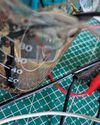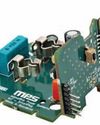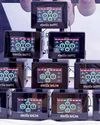HYBRID SUPERCAPACITORS: Emerging As A Better Choice For Residential And Commercial Use
Electronics For You
|July 2024
Hybrid supercapacitors and solar energy are reshaping energy storage, from India's solar boom to maintenance-free solutions.

Capacitors are a basic yet very important component in electronics. Imagine them as tiny batteries inside almost every electronic device, made up simply of two metal plates that store electric charge. However, there is a more advanced version called a supercapacitor. Supercapacitors use a special carbon material on the metal plates, which allows them to store more electricity and release it very quickly. This makes them perfect for tasks where energy needs to be used or saved very quickly, such as in the brakes of an electric car.
Supercapacitors are great at what they do, but they can’t hold as much energy as a regular battery, so they are not used for driving the car long distances. Instead, they work alongside the battery, particularly when the car needs a quick burst of energy or needs to save energy quickly, such as when braking. This not only helps the car run efficiently but also keeps the battery in good condition by preventing overcharging.
Some companies are working on hybrid supercapacitors, which combine features from both batteries and supercapacitors. They are designed for larger tasks, like storing energy in homes or for cellphone towers. This type of capacitor can handle a lot of energy and release it slowly over time, which is perfect for using solar or wind energy even when the sun isn’t shining or the wind isn’t blowing.
These hybrid systems are especially useful because they last a long time, they are safe, and they help reduce energy costs. They can shift energy usage to times when it is cheaper, and by doing so, they also help reduce the strain on energy grids. This not only saves money but is also better for the environment, as it helps cut down on greenhouse gas emissions.
Supercapacitors beat batteries
Diese Geschichte stammt aus der July 2024-Ausgabe von Electronics For You.
Abonnieren Sie Magzter GOLD, um auf Tausende kuratierter Premium-Geschichten und über 9.000 Zeitschriften und Zeitungen zuzugreifen.
Sie sind bereits Abonnent? Anmelden
WEITERE GESCHICHTEN VON Electronics For You

Electronics For You
Tech Majors Are Racing TOWARDS NET-ZERO - What About You?
Apple, Microsoft, Amazon, Google, Infosys, Wipro—global and Indian firms are heading closer to achieving net-zero emissions, a mandate to combat climate change. Here is what you need to know to start your journey...
12 mins
December 2025

Electronics For You
Miniature IoT WATER TDS And LEVEL MONITOR Cum CONTROLLER
For setups that rely on stored water, clear awareness of tank level and water quality is essential.
3 mins
December 2025

Electronics For You
The Impact Of GENERATIVE AI On The Future Of AUTOMOTIVE AND EVs
Autonomous vehicles, connected ecosystems, and smart factories are only the beginning. Generative Al is pushing the auto industry beyond predictions into a bold era of creativity-from EV design to real-time diagnostics and showroom automation. Here is how GenAl is reshaping innovation across the automotive value chain.
8 mins
December 2025

Electronics For You
How AI Tools Are Making SOFTWARE DEVELOPMENT BETTER
AI is reshaping how we code, debug, and collaborate. From Copilot to automation, it is changing software development in ways worth exploring.
3 mins
December 2025
Electronics For You
How AI Tools Are Making SOFTWARE DEVELOPMENT BETTER
AI is reshaping how we code, debug, and collaborate. From Copilot to automation, it is changing software development in ways worth exploring.
3 mins
December 2025

Electronics For You
5 Interesting Reference Designs FOR SMART HOMES
Smart home devices are transforming the way people interact with their appliances. They make homes more convenient, secure, and energy-efficient. From smart plugs and energy monitors to smart locks and thermostats, reference designs help design engineers create connected products that are easy to use, consume less power, and are reliable. These designs allow you to control devices remotely, track energy use, extend battery life, and automate routines. They provide practical solutions for upgrading homes and small commercial spaces without major modifications.
3 mins
December 2025

Electronics For You
Fancy USB LED VASE
This USB LED vase is a simple yet elegant device that fuses art with electronics to create a decorative lighting display. Powered directly from a standard USB port, it uses readily available components such as MOSFETs, resistors, capacitors, and LEDs to produce a striking, dynamic sequence of lights.
3 mins
December 2025

Electronics For You
"WHAT OTHERS SELL IN FOUR BOXES WE BUILT IN ONE"
Years of custom field work are shaping a product line with its own cloud, its own hardware, and a market that is now beginning to recognise its value.
8 mins
December 2025

Electronics For You
BUILD LARGE LANGUAGE MODELS
Large language models are machine learning models designed for a range of language-related tasks such as text generation and translation. Here’s how open source software can help you build your own large language model.
6 mins
December 2025

Electronics For You
Rare Earth Or Rare Ingenuity? India Remains Between The Two
With China firmly controlling rare earth exports, India confronts a critical moment in its technological trajectory.
8 mins
December 2025
Listen
Translate
Change font size

